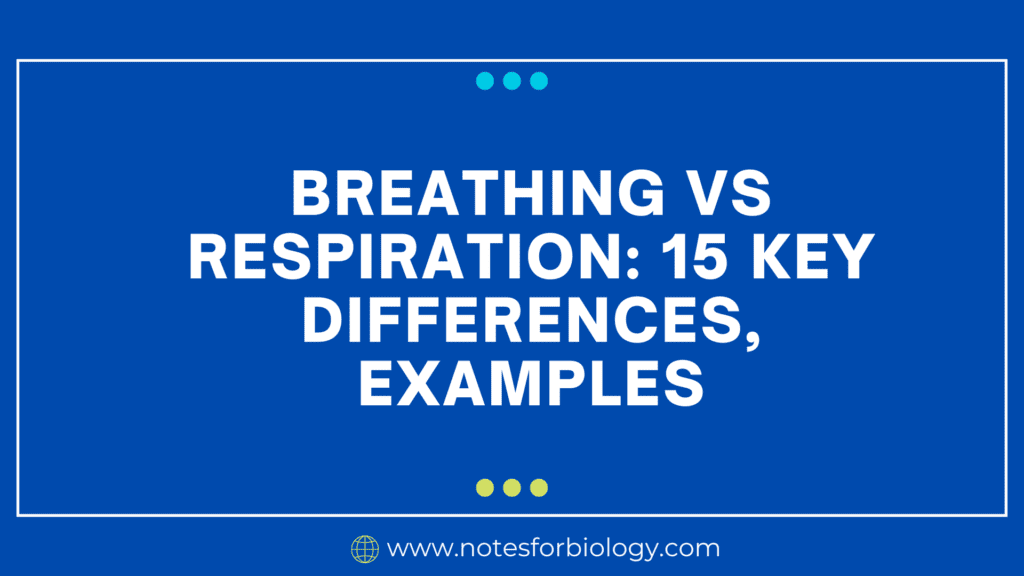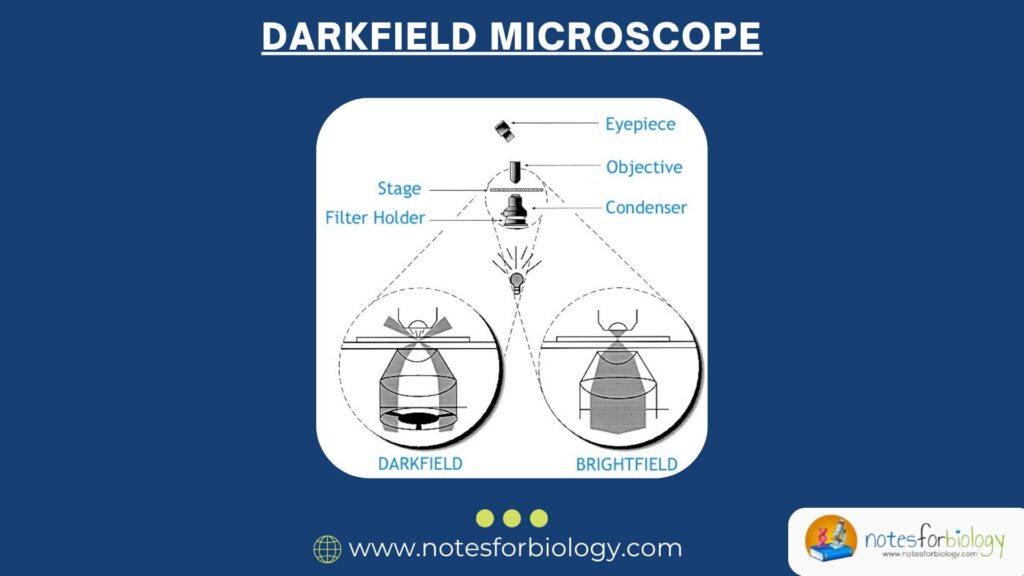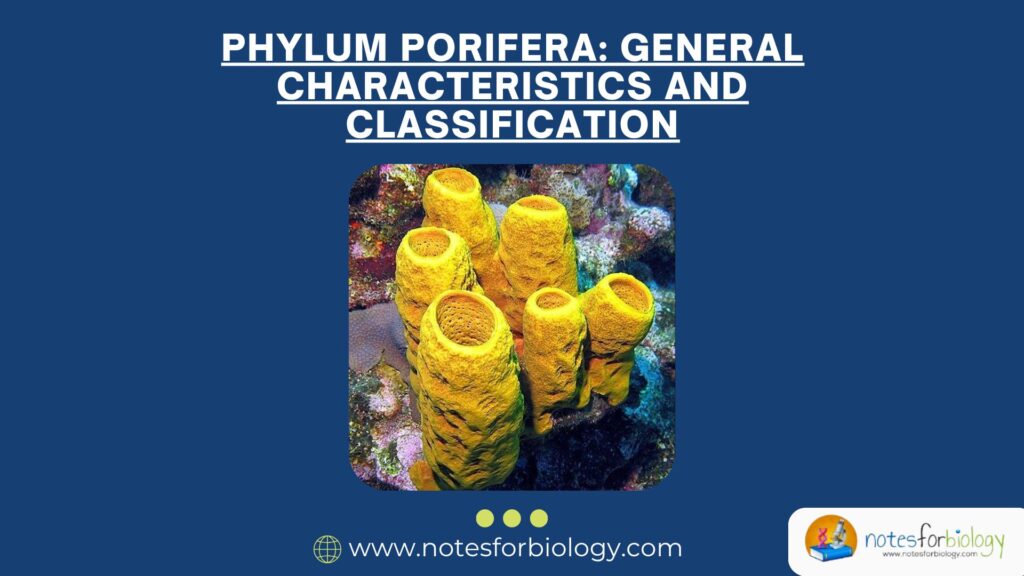Breathing vs Respiration fall under distinct but related categories in the context of biological processes. The mechanics of airflow into and out of the lungs are the main physiological processes involved in breathing. It includes the physical processes of breathing in and breathing out, which are powered by the organs of the respiratory system, including the diaphragm, lungs, and intercostal muscles. The biological process of respiration releases energy from organic substances, which can then be used to carry out various physical tasks.
Table of Contents
Breathing
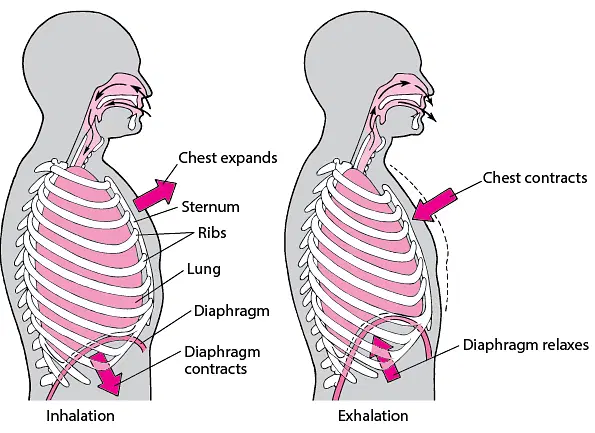
- Since breathing involves the external intake of oxygen and expulsion of carbon dioxide through the respiratory organs, it is often referred to as “external respiration.”
- All vertebrates use a highly branched network of tubes to connect their alveoli and nose during the breathing process.
- Breathing occurs in repeated cycles, and respiratory rate is the number of respiratory cycles per minute.
- Several homeostasis systems regulate the depth and rate of breathing under normal circumstances in order to preserve the blood’s partial pressure of carbon dioxide and oxygen.
- Since the lungs cannot expand on their own, the breathing mechanism includes the contraction and relaxation of several muscles located in the thoracic cavity.
- The diaphragm and the intercostals muscles contract to cause the lungs to expand, which causes the rib cage to move higher and outward in humans and most other vertebrates.
- The respiratory tree is reached by the air that is inhaled through the nose and travels through the nasal tube, pharynx, and larynx.
- The trachea, which is separated into multiple smaller branches, is the first branch in the respirator tree. Different organisms have different numbers of branches; for example, a mouse’s respiratory tree can have up to 13 branches, whereas humans have roughly 23.
- Thus, the air travels through these branches before arriving at the alveoli. The alveoli are the site of the gas exchange, where blood from the blood arteries diffuses into the oxygen and the alveoli diffuse into the carbon dioxide.
- The lungs constrict and the diaphragm and other respiratory muscles relax, allowing the carbon dioxide to be expelled. The process of exhaling is passive.
- Following this, the air in the lungs is forced upward and out of the body, returning to the atmosphere via the trachea and nasal route.
- Since breathing is a voluntary action, energy is needed for it. Breathing problems could arise from low energy.
Respiration
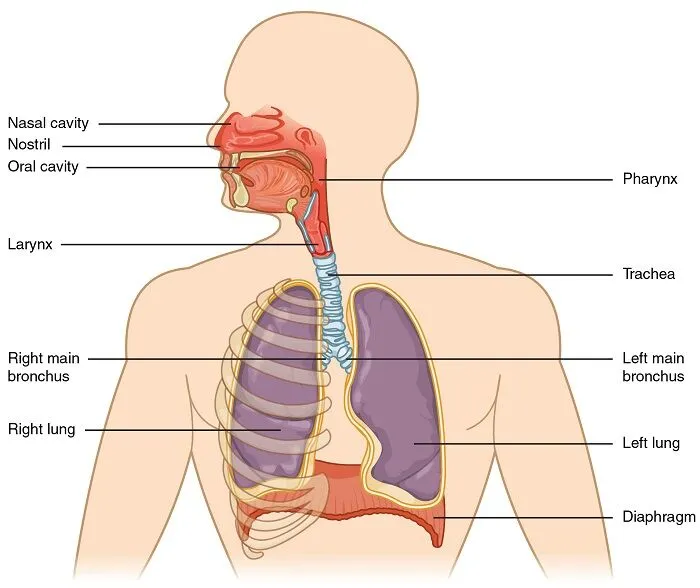
During Respiration, cells use oxygen to convert nutrients, especially glucose, into adenosine triphosphate (ATP), a chemical process that results in the production of carbon dioxide and water as waste. Maintaining cellular function and supplying the energy required for cellular processes depend on this mechanism.
- Because it is an internal process that releases energy and breaks down complex organic substances into carbon dioxide and water, respiration is sometimes known as “internal respiration.”
- In contrast to breathing, all living things experience respiration.
- If all the reactants are present, the process is involuntary and happens automatically.
- All of the body’s cells’ mitochondria are where respiration occurs.
- During the metabolic process of respiration, glucose is oxidized to produce carbon dioxide and water when there is oxygen present.
- Oxygen may be present or absent when respiration takes place. Anaerobic respiration occurs when there is no oxygen present in the air, whereas aerobic respiration occurs when there is oxygen present.
Breathing vs Respiration
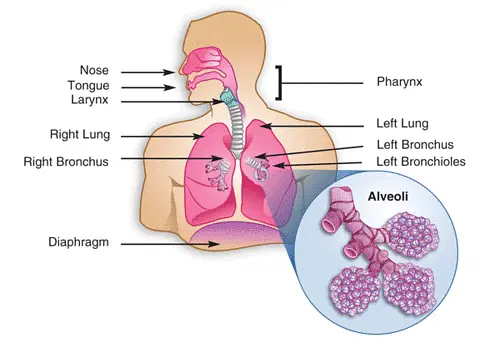
| S.N | Breathing | Respiration |
| 1. | A physiological process that involves inhaling and exhaling air through the respiratory system | A biochemical process that produce energy from glucose when oxygen is present |
| 2. | Enzymes are not involved. | Involvement of Enzymes are required. |
| 3. | It is a mechanical process | It is a chemical process |
| 4. | Breathing involves both active and passive processes | Respiration is only an active processes |
| 5. | It occurs between the body and external environment. | It takes place in cellular level. |
| 6. | It is an extracellular process as it occurs outside cells and no energy is produced during process. | It is an intracellular process as it occurs inside the cells and large number of enzymes are used during the process and energy is released in the form of ATP. |
| 7. | Inhalation and exhalation are the stages of breathing. | Glycolysis ,Krebs cycle and oxidative phosphorylation are the stages of respiration. |
| 8. | Gas exchange and ventilation are the major activities of breathing. | Gas exchange and break down of nutrients are the major activities of respiration. |
| 9. | Breathing uses ATP. | Respiration generates ATP. |
| 10. | Breathing does not produce energy . | Respiration produces energy and waste products. |
| 11. | Breathing provides oxygen for respiration while removing the carbon dioxide. | Energy is released in the form of ATP. |
| 12. | Measured by respiratory rate (breaths per minute)A normal adult breathing rate is 12-20 breaths per minute. | Measured by the rate of cellular respiration (metabolic rate) Basal metabolic rate (BMR) indicating energy expenditure at rest. |
| 13. | Continuous process, but can be paused momentarily. | Continuous and ongoing at the cellular level. |
| 14. | Helps maintain blood pH and gas concentrations. | Maintains cellular energy balance. |
| 15. | Involves the expulsion of carbon dioxide from the body | Produces carbon dioxide as a byproduct of metabolic processes |
Conclusion
So, above are the differences between Breathing vs Respiration . Both Breathing vs Respiration are the important concept in biology .Breathing vs respiration fall under distinct but related categories in the context of biological processes.
Frequently Asked Question(FAQ)
Define Respiration?
Respiration is a biochemical process that occurs at the cellular level. It involves metabolic pathways such as glycolysis, the Krebs cycle, and oxidative phosphorylation.
How are breathing and respiration connected?
In addition to removing carbon dioxide produced by cellular respiration, breathing provides the oxygen required for cellular respiration.
Why are breathing and respiration important?
In order to absorb oxygen, which is required for cellular respiration, one must breathe. The energy needed for different cellular processes and general body functions is provided by cellular respiration.
What are the stages of cellular respiration?
Glycolysis, the Krebs cycle (also known as the citric acid cycle), and oxidative phosphorylation (which includes the electron transport chain and chemiosmosis) are the three primary phases of cellular respiration.
Related Article

